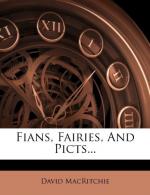But, although the popular memory may retain for many centuries the impress of historical facts, these become inevitably blurred and modified by the lapse of time and the ignorance of the very people who preserve the tradition. As an illustration of this, I may cite the instance of the dwarfs of Yesso, referred to in the following pages. These people still survived as a separate community until the first half of the seventeenth century, if not later. They occupied semi-subterranean or “pit” dwellings, and are said to have been under four feet in height. But, although the modern inhabitants of that island still describe them, on the whole, in these terms, a new belief regarding them has recently sprouted up in one corner. The Aino word signifying “pit-dweller” is also not unlike the word for a burdock leaf. It was known that those dwarfs were little people. Obviously, then, their name must have meant “people living under burdock leaves” (instead of “in pits"). And so, to some of the modern natives of Yesso, those historical dwarfs of the seventeenth century “were so small that if caught in a shower of rain or attacked by an enemy, they would stand beneath a burdock leaf for shelter, or flee thither to hide."[4]
In that instance, we see before our eyes the whole process by which a real race has been transformed into an unreal impossibility, within a period of two centuries or so. Had the extinction (or modification by inter-marriage or by the processes of evolution) of those Yesso dwarfs taken place a thousand years earlier, the difficulty of identifying them would have been greatly increased. After a race has once disappeared from sight, the popular terms describing it must become more vague and confused with every century. Thus, in a certain traditional Scotch story there is mention of a number of “little black creatures with spades.” The description is delightfully comprehensive. It would be quite applicable to a gang of Andaman coolies. On the other hand, if we exclude the “spades,” it might be applied to any “little black creatures”—say a colony of tadpoles or of black-beetles. So that, when a poet or an artist gets hold of a tradition which has reached this stage of uncertainty, he may give the reins to his fancy, so long as he portrays some kind—any kind—of “little black creatures."[5]




